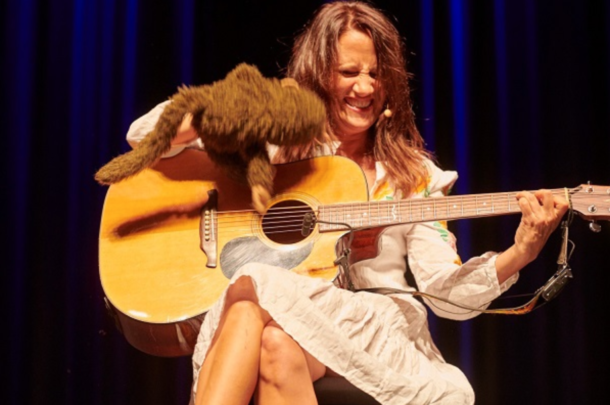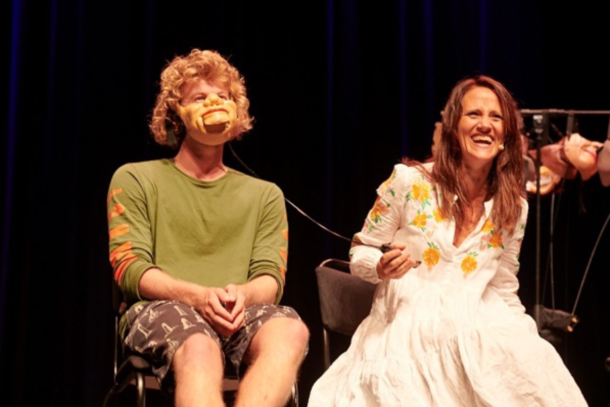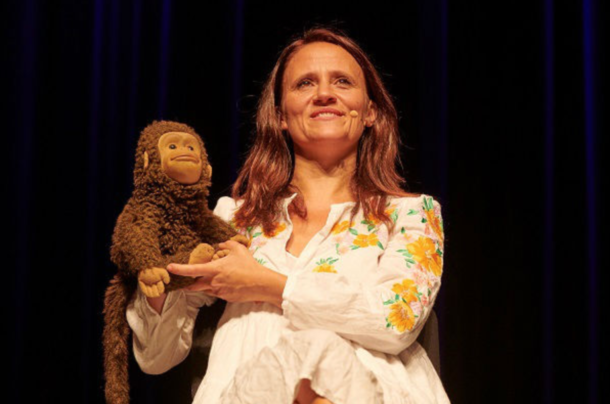A woman climbs into a large, black sack saying, “So I just get in here?” A tiny, painfully adorable monkey replies, “Yes, and stop pretending that it isn’t your idea, anyway. That disingenuous shit is exactly what I’m talking about.” Monkey—Monk for short—hurls frequent abuses at the most important woman in his life, his puppeteer and ventriloquist Nina Conti. Without her, he would be a lifeless bit of fake fur in the shape of a small animal made in Taiwan (we learn this in the course of the evening). In Your Face, one of Conti’s several full-length solo works, previewed in London at the Soho Theatre before premiering at the Melbourne Town Hall during the Melbourne International Comedy Festival (MICF) season on March 26, 2015. I saw the production on March 23, 2019, as part of Tricklock Company’s Revolutions International Theatre Festival at The Kimo Theatre in Albuquerque, New Mexico.

In Your Face, performed by Nina Conti, directed by Bill Dare at the Lund Comedy Festival Sweden. Photo: Charlotte Strömwall.
Theatrical magic abounds during In Your Face, made all the more wonderful considering the sparsity of scenic elements: one acoustic guitar leaning on a stand, a chair sat center stage, a microphone-in-wait, and several mask-contraptions hanging playfully from a T-shaped rack. And of course, there is the inimitable Conti herself, a UK-based entertainer of the stage and screen. She received the MICF Barry Award for her 2008 solo show Complete and Utter Conti, and enjoyed sold-out seasons of her 2010 solo Talk to the Hand in London, Edinburgh, Melbourne, the Sydney Opera House, and New York. Having begun at The Royal Shakespeare Company, Conti came to the vaudevillian vestige of ventriloquism later with encouragement from Ken Campbell, an English theatre director with a reputation for the surreal.
Though Conti has several personages to whom she lends her voice, her staple sidekick is the salty simian monikered Monkey. His head pokes out from the top of a large yellow purse, subverting the cliché of a rich girl with a tiny dog in a Gucci bag. For Monkey’s human hand-size stature, he projects an incredibly large personality and depth of expression. The conscious mind can rationalize this, remembering that it is the skill of this highly practiced performer. However, Monkey’s character is so compelling and expertly delivered that rationality soon falters and one finds that he is quite real. This illusion gives Conti a great gift, which she does not take for granted. Monkey becomes a medium to liberate her id-like, darker impulses and thoughts. It expands how a puppet can function: not only is Conti bringing this character called Monkey to life to sit alongside her, he also acts as a channel, transmitting ordinarily silenced aspects of her psychological anatomy. She gets to be both the angel and the devil at once. And what’s more, the audience loves Monkey, particularly when he is at his nastiest or most shocking. If Conti herself were to utter the wild, lascivious, and mean things that are Monkey’s modus operandi, it is difficult to imagine her having as solid a rapport with her audiences. Through her ventriloquism, Conti turns her mentality inside-out, giving an unfiltered view into the whole whimsical, sometimes wicked world within.
The show begins with Monk and Conti chatting with one another, establishing their friendship. They soon turn their attention to select members of the audience, polling them with “get-to-know-you” questions about what they do, if they have brought anyone to the show, and so on. After these little interviews, she and Monkey choose people and invite them to participate voluntarily on stage. As they make their way, she gets busy choosing one of the masks which have been hanging behind her. Conti takes a few moments to gently secure the mask on the face of the participant, which covers their mouth. She begins to manipulate a hand-held silicone bulb attached to the mask by a thin tube, which makes the mouths open and close. This allows her to “speak” for her audience volunteers. She creates characters for them based on the scant real-life details she has extracted from them during the opening, one or two questions she asks right before applying the mask, and on her sheer (and well-honed) instinct. She watches for even the smallest and subtlest of body language to give her inspiration for what to say and how. The process of finding each character’s voice happens quickly, in tandem with the gestural life and eye expressions of the volunteer. It is riveting to see.

In Your Face, performed by Nina Conti, directed by Bill Dare at the Lund Comedy Festival Sweden. Photo: Charlotte Strömwall.
The mask design is uncanny; each half-face is so brightly colored and bulbous that the resulting image is almost as if Conti were standing on stage with real-life cartoons. “You’re controlling my mouth!” one of her volunteers exclaims, or rather, Conti exclaims on their behalf. She never lets the audience get too lost in the daydream that the masks are real faces. These moments are Brechtian in their self-cognizance, consistently pointing to what is “really going on.” She frequently jolts viewers awake with these reflexive quips, which reveal the sleight of hand a more traditional ventriloquist might try hard to veil. That transparency is part of Conti’s dramaturgical genius, and also evokes consistent, hearty laughter from the crowd.
More recently, on August 13, 2019, I witnessed Conti’s limited-run performance Work in Progress at Pleasance Courtyard during the Edinburgh Fringe Festival. Though the title might suggest an unfinished—as in, raw—performance, Conti steadily delivers her indefatigable razor-sharp wit, overflowing joy, and imagination so alive it requires several human—and stuffed animal—helpers to realize its magnitude. Straight away, she sets a “work in progress” mood, appearing in an untucked blue tank top and off-white, knee-length skirt. Her long brown hair is down, natural, and she looks relaxed. Her first address to the audience establishes the structure of the evening: Conti will spend 50 minutes messing around, “chasing the laughs,” and will record the material, later using the archive to create a new full-length show. This brilliant set-up harkens to the genius of In Your Face in its overtness. As with In Your Face, she and Monkey open the evening conversing with the audience, and again she involves volunteers in performing with her while they wear half-masks. This time, though, they are joined by a musician who offers an occasional melody when the improvisation wants to take a musical turn. Having another artist on the stage serves to signal when something is exceptionally surprising or hilarious. When he is caught off guard with delight, there is a little extra jolt of electricity on stage. At one such point, during a scene between Conti and two masked volunteers, one of them says, “Nobody’s talking but Nina.” The musician shudders, giggling, and thunderous laughter explodes from the audience with this bit of classic Conti comedy. To use the descriptor “schtick” would be reductive. These moments transcend trickery, moving beyond technical virtuosity to a ravishing self-awareness that leaves the viewer to revel ecstatically in Conti’s reflexivity.
During In Your Face, every time Conti reinforces that she is the puppet master, she is priming a tension between reality and fantasy that builds to the finale. In Your Face is actually Monkey’s story, and though we meet and get to know a few be-masked volunteers along the way, the real struggle we follow is something that troubles him from the outset: Will Monkey achieve the sense of independence he so craves? A true friend, Conti, tries to erase herself so that he might be the center of attention for once. Hiding herself inside the aforementioned black sack is one attempt to give Monkey the spotlight, but still leaves him feeling like Conti is too present, so they take a different strategy. Insisting that she must trust him, he instructs her to put down the yellow bag, which hides her puppeteering arm. She acquiesces, though cannot help but cup her other hand under that elbow. He tells her to relax her free arm. She does, slowly. He then directs her to take him off her hand and put him away, back inside the yellow bag. With the trepidation of a magician showing their best trick, but also wanting to honor his wish, she removes her hand. His body immediately falls limp. She places the lifeless toy into the bag. Monkey is not gone, though, he is still vocalizing through Conti. They continue to talk, this time with nothing between them but a change in pitch. He delivers his final request: that she let him take her over. This is too much, she argues with him but it’s too late, he’s already too far inside of her, the struggle becomes visible, the woman and the monkey are suddenly engaged in a violent, existential brawl. Suddenly, Conti’s body wrenches like a serpent heaving out an evil spirit, and Monk yowls triumphantly, “Finally, I got rid of the bitch!” There is an abrupt plunge into darkness as the audience erupts into sounds of joyful disbelief at the transmutation that just occurred, cheering wildly in a spell-bound madness. Deftly toggling between playful conceit and cunning candor is Conti’s witchcraft, which she wields powerfully. Her silver-tongued sorcery brings her audience to question: “How’d she do that?” in an entirely new way because how she does it is actually before their very eyes.

In Your Face, performed by Nina Conti, directed by Bill Dare at the Lund Comedy Festival Sweden. Photo: Charlotte Strömwall.
Katy Houska is a performer, producer, and teaching artist in the Albuquerque-based international theatre Tricklock Company, currently serving as Program Director for its teen ensemble theatre institute The Manoa Project. She holds a Diploma from the theatre program at l’Ecole Philippe Gaulier, and is currently working on her BA in Theatre at the University of New Mexico.

European Stages, vol. 14, no. 1 (Fall 2019)
Editorial Board:
Marvin Carlson, Senior Editor, Founder
Krystyna Illakowicz, Co-Editor
Dominika Laster, Co-Editor
Kalina Stefanova, Co-Editor
Editorial Staff:
Stephen Cedars, Assistant Managing Editor
Dohyun Gracia Shin, Assistant Managing Editor
Advisory Board:
Joshua Abrams
Christopher Balme
Maria Delgado
Allen Kuharsky
Bryce Lease
Jennifer Parker-Starbuck
Magda Romańska
Laurence Senelick
Daniele Vianello
Phyllis Zatlin
Table of Contents:
- The 73rd Avignon Festival, July 4-23, 2019 : Odysseys, past, present and future by Philippa Wehle.
- Ibsen in London by Marvin Carlson.
- Report from London (November – December, 2018) by Dan Venning.
- It’s All in the Wrist: How Nina Conti Faces Off with Reality by Katy Houska.
- Staging Trauma: A Review of Bryony Kimmings’s I’m a Phoenix, Bitch by Rachel Anderson-Rabern.
- Difficult Pasts and Revivals: Madrid Theatre Summer 2019 by Maria M. Delgado.
- Cultural Diversity in the Kunstenfestivaldesarts (Brussels) 2019 by Manuel García Martínez.
- Tampere Theatre Festival: Progressing Society by Pirkko Koski.
- Nasza Klasa in Georgia by Mikheil Nishnianidze.
- Young and Critical Voices of Turkey I: “Theatre helps us to hear each other.” A Conversation with Irem Aydın by Eylem Ejder.
www.EuropeanStages.org
europeanstages@gc.cuny.edu
Martin E. Segal Theatre Center:
Frank Hentschker, Executive Director
Marvin Carlson, Director of Publications
©2019 by Martin E. Segal Theatre Center
The Graduate Center CUNY Graduate Center
365 Fifth Avenue
New York NY 10016
European Stages is a publication of the Martin E. Segal Theatre Center ©2019
Martin E. Segal Theatre Center:
Frank Hentschker, Executive Director
Marvin Carlson, Director of Publications
©2019 by Martin E. Segal Theatre Center
The Graduate Center CUNY Graduate Center
365 Fifth Avenue
New York NY 10016
European Stages is a publication of the Martin E. Segal Theatre Center ©2019



